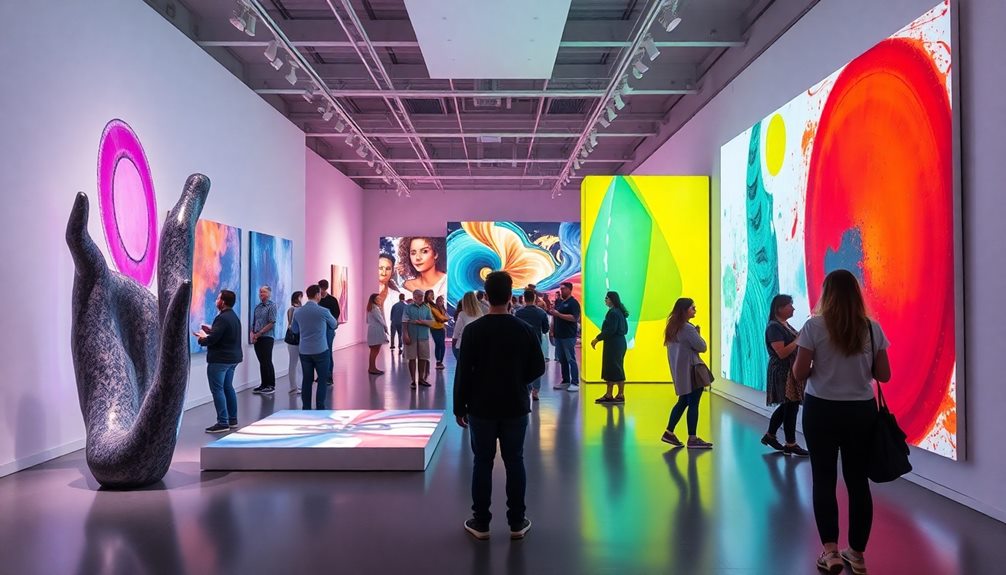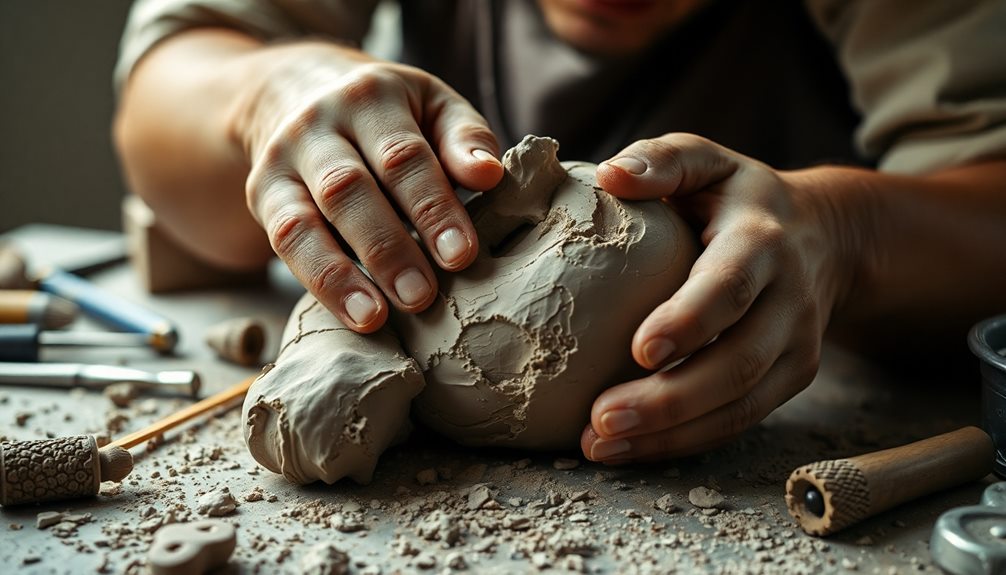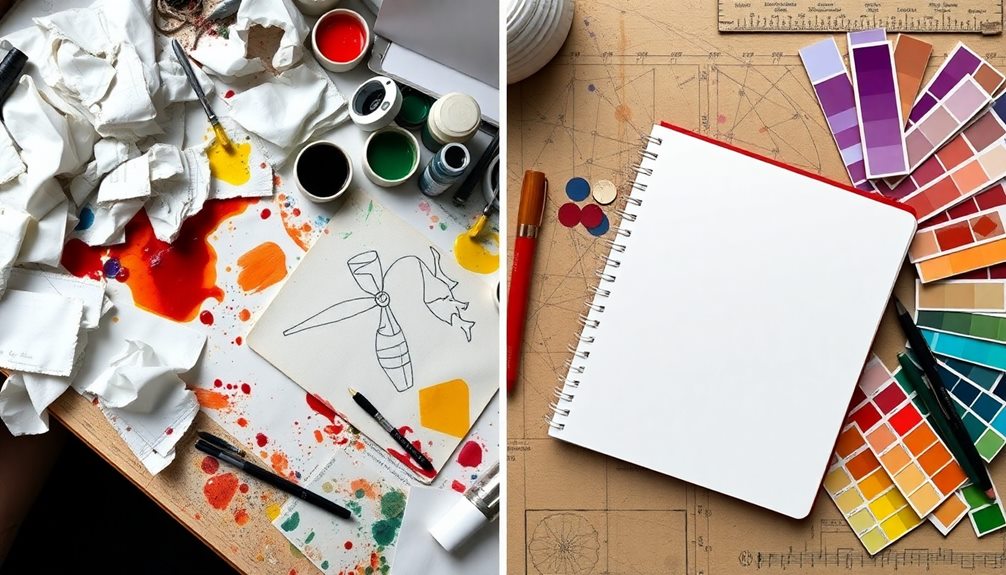To write an art appreciation essay, start by introducing the artwork with its title and artist. Create a strong thesis statement to guide your analysis. Focus on visual elements like line, color, and texture while considering historical and cultural contexts. Use clear, engaging descriptions and art vocabulary to enrich your insights. Structure your essay with a compelling introduction and supportive body paragraphs that flow logically. Finally, consider incorporating personal reflections and feedback for improvement. By following these steps, you'll gain a deeper connection to the artwork and enhance your critical thinking skills. There's much more to explore to perfect your essay!
Key Takeaways
- Start with a strong thesis statement that encapsulates your perspective on the artwork and guides your analysis.
- Provide historical and cultural context to deepen understanding of the artist's intent and the artwork's significance.
- Conduct a detailed formal analysis of visual elements and design principles to support your interpretation.
- Incorporate credible sources and art vocabulary to enhance clarity and strengthen your arguments.
- Engage readers with vivid descriptions and personal insights to create emotional connections with the artwork.
Introduction

When diving into an art appreciation essay, the introduction sets the stage for your exploration of the artwork's significance and emotional resonance. Start by introducing your primary artwork, including the artist's name and the title of the work. This immediately grounds your reader and provides a focal point for your analysis.
Next, craft a strong thesis statement that encapsulates your argument or perspective on the artwork. This will guide your essay's direction and help clarify your intent.
Incorporating elements of spiritual transformation can enhance your analysis, as many artworks reflect deeper meanings associated with personal growth and enlightenment.
Don't forget to weave in the historical background and cultural context of the piece. This information enriches your discussion, allowing readers to appreciate the artwork's relevance within its time and society. Highlighting these elements also helps to uncover the artist's intent, making it easier for your audience to connect emotionally with the work.
You might even open with a thought-provoking question or a striking observation about the piece to engage your reader's interest right away. By setting this foundation, you'll prepare your audience to delve deeper into the emotional impact and significance of the artwork as they accompany you on this analytical journey.
Key Concepts and Definitions

Understanding key concepts and definitions is crucial for crafting an insightful art appreciation essay. You'll want to dive into the visual elements like line, color, shape, and texture, as these components significantly impact how an artwork is perceived.
Additionally, familiarizing yourself with design principles such as balance, contrast, and unity can help articulate the piece's overall meaning. Emphasizing a user-centric approach in your analysis can also enhance your understanding, as design thinking fosters empathy in appreciating the artist's intentions.
Historical context is also vital; it shapes both the creation and reception of art. Recognizing the cultural and social influences behind a work can enhance your interpretation. As you analyze an artwork, don't just describe what you see—explore the emotional aspects and feelings it evokes. This deeper engagement fosters a personal connection between you and the artwork.
Using critical vocabulary is essential in your essay, as it enables you to express your insights and evaluations clearly. This vocabulary will enhance your overall understanding and appreciation, allowing you to communicate effectively about the artwork's significance.
Essential Elements of Art Essays

Crafting an art essay involves weaving together several essential elements that elevate your analysis and engagement with the artwork. Start with a clear thesis statement; this acts as your compass throughout the essay, guiding your argument.
In art essay writing, the introduction should be engaging, capturing your reader's interest while laying the groundwork for your analysis paper. Additionally, consider how the emotional impact of the artwork can be influenced by various elements, much like how essential oils for toothache relief can provide a calming effect.
When writing the main body, focus on formal analysis, dissecting the key elements and principles of the artwork. Explore aspects like form, color, and design, moving beyond mere description to articulate the piece's meaning and significance. Each paragraph should flow logically, supporting your thesis with evidence and insight.
Don't forget to incorporate art vocabulary and high-quality images to enhance your essay. These elements allow for precise descriptions, deepening the reader's understanding of the essential features discussed.
Real-World Art Essay Analyses

Art essay analyses in the real world often delve into the intricate relationships between different artworks, unveiling their unique characteristics and shared themes. When writing about art, you might engage in a compare and contrast essay that highlights similarities and differences in artistic style, technique, and cultural context. This approach deepens your understanding of each piece's significance.
An effective analysis includes a detailed examination of formal elements like line, color, form, and composition. This scrutiny enables a richer interpretation of the artist's intent and the artwork's impact.
Moreover, acknowledging historical events is crucial, as it situates the work of art within specific cultural, political, or social frameworks that influenced its creation and reception.
Incorporating credible sources, such as scholarly articles or critiques, enhances your analysis by providing a solid foundation for your arguments. A well-structured art essay typically follows a clear format: an introduction presenting your thesis, body paragraphs exploring the artworks in depth, and a conclusion that synthesizes your findings and reflects on their broader implications.
This structured approach makes your analysis not just informative but also engaging.
Tips and Best Practices

Effective art appreciation essays hinge on a well-defined thesis that articulates your perspective on the artwork. Start your essay with a clear thesis statement that sets the stage for your argument. This helps the reader understand your viewpoint right from the beginning.
Next, dive into detailed visual analysis. Discuss the elements and principles of art, such as line, color, texture, and composition, to provide a comprehensive understanding of the artwork's aesthetic qualities.
Don't forget to contextualize the piece by exploring its historical background, including the artist's biography and influences that shaped their work. This enriches your analysis and helps your reader appreciate the art on a deeper level.
When it comes to structure, ensure your essay flows logically. Begin with an engaging introduction, followed by body paragraphs that support your thesis with evidence, and conclude by reinforcing your main points without introducing new information.
Lastly, always proofread your essay. Check for clarity and coherence, ensuring your arguments flow logically, and correct any grammar, punctuation, or spelling errors to maintain a formal academic tone. This attention to detail will elevate your art appreciation writing.
Audience Engagement and Feedback

When writing an art appreciation essay, engaging your audience is crucial for making the artwork come alive. Use vivid descriptions to paint a picture with words, allowing your readers to visualize the art and connect with it emotionally. Incorporate questions throughout your essay; this stimulates curiosity and encourages readers to reflect on their interpretations.
Providing historical context and artist background can significantly enhance audience understanding. When you explain the circumstances surrounding the artwork, it helps readers grasp its significance and relevance.
Don't forget to weave in your personal insights or reactions; these create a more intimate narrative that invites readers to share in your experience.
Seeking feedback from peers or instructors before final submission is also essential. Their insights can reveal areas for improvement that you might've overlooked. By incorporating constructive criticism, you ensure your essay resonates well with your intended audience.
Cultural Context Awareness

Understanding the cultural context of an artwork is essential for deepening your appreciation and interpretation of it. By analyzing the historical period, social dynamics, and political influences surrounding an artwork's creation, you can gain valuable insights.
The artist's background, including their ethnicity, religion, and economic conditions, also plays a significant role in shaping the subject matter and themes.
Art movements reflect the values and beliefs of the society in which they emerged, making it crucial to consider these elements when interpreting a piece. Engaging with the cultural context allows you to recognize how art communicates contemporary issues, fostering a deeper connection to the work.
You can enhance your appreciation by researching specific art movements and artistic styles that were prevalent during the artwork's creation. This exploration helps you understand the themes and symbols present in the piece, revealing the artist's intent and the message they hoped to convey.
Additional Resources

To truly enrich your art appreciation essay, tapping into additional resources can significantly enhance your research and writing process. Start by utilizing credible resources such as books, scholarly articles, and reliable internet sources. These will provide essential support for your thesis and arguments.
Online databases and university guides are particularly valuable for structured approaches to visual analysis, helping you grasp artistic techniques and historical context.
Don't overlook glossaries of art terminology, like those from the British National Gallery, which can assist you in accurately describing and analyzing art elements and principles in your essay.
Investigating examples of high-quality art appreciation essays will also inform your essay structure, showcasing effective arguments and writing styles.
Lastly, consider accessing resources from organizations like the Kennedy Center or Duke University, which offer guides on visual analysis. These resources will enhance your analytical skills and deepen your interpretation of artworks.
Frequently Asked Questions
How Do You Write a Complete Essay Guide?
To write a complete essay guide, you'll need to outline your main points, define key terms, and provide clear instructions. Organize your content logically, ensuring each section flows coherently to support your overall argument or purpose.
How Do I Start off an Art Essay?
To start off your art essay, grab your reader's attention with a captivating hook or quote. Then, clearly state your thesis, providing essential background about the artist and artwork to set the stage for analysis.
What Is the Format of the Art Essay?
The format of your art essay should include an engaging introduction, well-structured body paragraphs discussing various elements, and a concise conclusion that summarizes your key points and emphasizes the artwork's significance.
What Are the 5 Steps in Art Appreciation?
To appreciate art, you'll follow five steps: observe the details, contextualize the piece, analyze its elements, interpret its themes, and evaluate its significance. Engaging in these steps deepens your understanding and enjoyment of the artwork.
Conclusion
In wrapping up your art appreciation essay, remember to connect your insights to the broader cultural context and the emotions art evokes. Emphasize the personal impact and significance of the artwork while incorporating the essential elements discussed. Don't forget to engage your audience by inviting their thoughts and reflections. By following these guidelines, you'll create a compelling essay that not only showcases your understanding but also sparks meaningful conversations about art. Keep exploring and appreciating!









